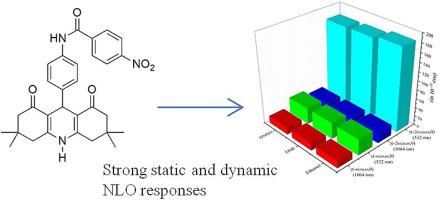Exploration of DFT-based static and dynamic nonlinear optical activity of an acridine-1,8-dione derivative
IF 3.4
4区 化学
Q2 CHEMISTRY, MULTIDISCIPLINARY
引用次数: 0
Abstract
In this study, DFT-based analyses of nonlinear optical (NLO) properties of an acridine-1,8-dione derivative were performed, and its experimental UV–vis spectra were recorded in neutral and alkaline media. In the alkaline medium, n-π∗ transition shows a shift of about 100 nm with the appearance of yellow color, which can easily be detected through the naked eye. DFT-based various geometric parameters and global reactivity descriptors of NPB and its deprotonated form () were computed. The TDDFT-generated UV–vis spectrum was found to be consistent with the experimental one. Bond-length alternation indicates that the dominating charge-separated resonating form in the ground state leads to higher βtotal. NPB shows a higher static NLO response compared to urea molecule (160 times higher and 154 times higher in DMSO) as well as some reported acridine-1,8-dione and 1,4-DHP-derivatives. Therefore, to check its potential as an NLO material, dynamic NLO parameters were also explored. At a lower frequency (532 nm) , , and values are significantly higher. Furthermore, a higher non-linear refractive index at 532 nm confirms its application as a potential NLO material.

基于dft的吖啶-1,8-二酮衍生物静态和动态非线性光学活性的探索
在本研究中,基于dft分析了吖啶-1,8-二酮衍生物的非线性光学性质,并记录了其在中性和碱性介质中的实验紫外可见光谱。在碱性介质中,n-π *跃迁表现出约100 nm的位移,并呈现黄色,这可以很容易地通过肉眼检测到。计算了基于dft的NPB及其去质子化形式(NPB−)的各种几何参数和整体反应性描述符。发现tddft生成的紫外-可见光谱与实验一致。键长交替表明基态中占主导地位的电荷分离共振形式导致较高的β总量。与尿素分子相比,NPB表现出更高的静态NLO响应(在DMSO中β总高160倍,γ0高154倍)以及一些报道的吖啶-1,8-二酮和1,4- dhp衍生物。因此,为了验证其作为NLO材料的潜力,还探索了动态NLO参数。在较低频率(532 nm), βSHG、βHRS和γEFISHG值显著升高。此外,在532 nm处具有较高的非线性折射率,证实了其作为一种潜在的NLO材料的应用。
本文章由计算机程序翻译,如有差异,请以英文原文为准。
求助全文
约1分钟内获得全文
求助全文
来源期刊
CiteScore
3.50
自引率
7.70%
发文量
492
审稿时长
3-8 weeks
期刊介绍:
The Journal of the Indian Chemical Society publishes original, fundamental, theorical, experimental research work of highest quality in all areas of chemistry, biochemistry, medicinal chemistry, electrochemistry, agrochemistry, chemical engineering and technology, food chemistry, environmental chemistry, etc.

 求助内容:
求助内容: 应助结果提醒方式:
应助结果提醒方式:


